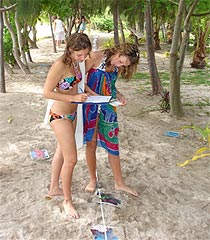VELS - Allowing marine studies to come to life
What I learned at the courses of 2005
Ripple effect The next stage was to take this type of monitoring and make it usable for students. My target was a group of Year 9 students that would be coming to Fiji with me. I found that the students generally learnt the species and could identify many of the substrates, fish and invertebrates. This worked when students where taught specific areas and not the whole lot, but accuracy over the whole survey area became an issue.
So I came away reasonably satisfied that we had produced some worth while data for the parent organization, data that they could use from an area that had not produced data for several years.
Reef Check Australia appreciated our efforts, enjoyed receiving the data we had collected and the photos of the training and survey we had taken. It also meant that Fiji, or at least our small part was included in the Reef Check global report for 2005. |

Figure 3: Students doing
transect training in Fiji |
It is important that research organizations like Reef Check are able to train others. Organizations’, like Reef Check and Coral Cay, rely on either paying volunteers’ or donations from the private sector to run their organizations and they can’t, due to there size, actually monitor many of the worlds reefs themselves. So that they can cover more reefs they need groups like students who are interested to be trained and report back to them the results of surveys, and so the organizations can get a better view of the world’s reefs.
Coral Cay spends 2 full weeks training its monitors, while as I have said, the Reef Check course with only 2 people on it was a solid 6 days with pre-reading and exams. This makes it difficult to teach and train Year 9 students, however it is important for students to see the full monitoring system that is required.
|